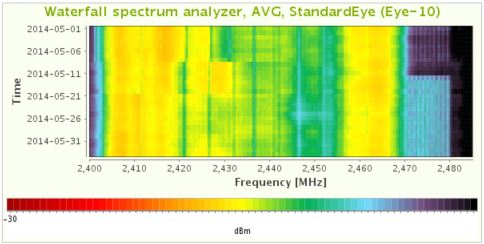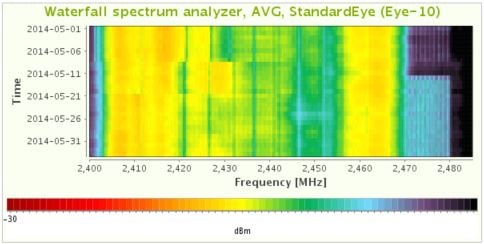
Blog
Spectrum analysis is a layer 1 technology for identifying presence, type, level and location of RF interference. Today's wireless access point integrated spectrum analysis functionality does not run continuously, which is a significant limitation. Integrated spectrum analyzers commonly use the same radio chip for WLAN spectrum analysis and for serving client devices. For this reason, they drop end user traffic packets while they go off scanning the spectrum, typically 30ms in each second unless a dedicated spectrum analysis sensor is used.
While TCP protocol may recover from these outages through TCP level retries at the expense of throughput, UDP does not. UDP protocol does not support retransmissions and packets are permanently lost. For reasons like this, integrated spectrum analysis may often be turned off until there is a suspected WLAN interference problem. So you can see there is an issue here with being reactive. Often the first information about a potential network issue comes from end users and by then, productivity has been disrupted and it's already too late in the game.
A lot of times when Wi-Fi is performing poorly, someone will first turn to the spectrum analyzer to find a culprit, but this can be a mistake. Wi-Fi itself creates a lot of radio energy which is present and visible in the spectrum. Wi-Fi can work in the presence of other radio interference as well, and before you start blaming Bluetooth or microwave, it is important to understand the how the packet flow is or is not impacted.
It's very difficult to determine the end user impact from spectrum analysis data. As an example, integrated spectrum analyzers often provide an abstract interference index scaling from 0-100%. This metric does not tell or cannot be meaningfully correlated with neither the client's user experience nor network performance. This is a significant challenge. Spectrum analyzers operate on layer 1, where signals are constantly varying their RF energy.
A Different Approach
It is useful to proactively and continuously measure the level of WLAN interference and try to correlate it with how the network was performing at the same time. This can be accomplished with a trending tool measuring the packet flow characteristics over a longer period of time and by providing continuous operational high resolution (280 kHz) spectrum analysis at 2.4 GHz band with beam steering. The density of the spectrum samples is defined by a test profile. Spectrum information is used together with other network performance and QoE data.
With 7signal, analysis flow starts from layers 4-7 and works down towards the spectrum analysis at layer 1. Higher level data indicates the level of impact the end users are experiencing. User experience trending data (connectivity, throughput, jitter) and radio packet analysis (data rates, retries, air utilization) data is correlated with WLAN spectrum analysis results. This allows you to quickly identify the overall impact as well as the magnitude of the impact. Dominating interference may be caused by high air utilization from WLAN traffic itself or from a less than an optimal channel plan.
Measurements that run proactively and continuously do not interfere with end user traffic. The data captured by the directional antenna array is stored in a database so that spectrum analysis can show trends over many weeks or it can narrow it down to a couple of hours. Each antenna direction may be analyzed separately for locating and identifying the source of interference.
Unfortunately, more often than not, interferers cannot always be removed. As a result, the WLAN network needs to be adjusted and hardened to cope with the environment. As an example, the most common source of non-WLAN interference is Bluetooth. Its presence can be seen across the 2.4 GHz frequency band as spikes in spectrum with 1 MHz or 2 MHz separation. In most areas, it's not possible to remove Bluetooth traffic, so other strategies are needed. However, whenever possible, the causes of WLAN interference should always be removed.
